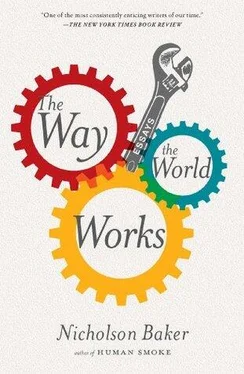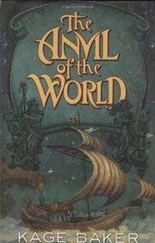Nicholson Baker - The Way the World Works
Здесь есть возможность читать онлайн «Nicholson Baker - The Way the World Works» весь текст электронной книги совершенно бесплатно (целиком полную версию без сокращений). В некоторых случаях можно слушать аудио, скачать через торрент в формате fb2 и присутствует краткое содержание. Год выпуска: 2012, Издательство: Simon & Schuster, Жанр: Публицистика, Критика, на английском языке. Описание произведения, (предисловие) а так же отзывы посетителей доступны на портале библиотеки ЛибКат.
- Название:The Way the World Works
- Автор:
- Издательство:Simon & Schuster
- Жанр:
- Год:2012
- ISBN:нет данных
- Рейтинг книги:4 / 5. Голосов: 1
-
Избранное:Добавить в избранное
- Отзывы:
-
Ваша оценка:
- 80
- 1
- 2
- 3
- 4
- 5
The Way the World Works: краткое содержание, описание и аннотация
Предлагаем к чтению аннотацию, описание, краткое содержание или предисловие (зависит от того, что написал сам автор книги «The Way the World Works»). Если вы не нашли необходимую информацию о книге — напишите в комментариях, мы постараемся отыскать её.
), here assembles his best short pieces from the last fifteen years.
The Way the World Works
OED
Modern Warfare 2
Through all these pieces, many written for
, and
, Baker shines the light of an inexpugnable curiosity.
is a keen-minded, generous-spirited compendium by a modern American master.
The Way the World Works — читать онлайн бесплатно полную книгу (весь текст) целиком
Ниже представлен текст книги, разбитый по страницам. Система сохранения места последней прочитанной страницы, позволяет с удобством читать онлайн бесплатно книгу «The Way the World Works», без необходимости каждый раз заново искать на чём Вы остановились. Поставьте закладку, и сможете в любой момент перейти на страницу, на которой закончили чтение.
Интервал:
Закладка:
This abundance of manufactured chop — known to Venetians by the ominous name of moto ondoso —accelerates the decay of the city’s foundational stonework. And it makes life difficult for the venturesome gondolier, who stands upright on a bit of carpet high on the upcurving tailpiece of a half-ton craft without a keel, trying, as he and his counterweighted, steel-pronged prow seesaw unrestrainedly, to propel it forward with one oar levered against a gnarl of polished walnut. His boat, with its sinuous, side-rocking way of proceeding by self-correctingly veering off course, is a curiosity, maybe even a marvel, of evolved hydrodynamics, but its peculiar nautical graces and efficiencies only assert themselves when it moves over relatively smooth water. A number of gondoliers say that the Giudecca Canal is dangerous. Bruno Palmarin avoids it not because it frightens him but because he thinks he looks out of place there. “In the choppy water, when you are struggling, when you are distrait, you feel ridiculous,” he said to me. “You feel like a clown.”
But on our wedding day, my veiled fidanzata —a gutsier import-word perhaps than the prissy-sounding fiancée —had a good time going across. “Out in the middle of the canal it was perfect,” she says now. “Everything looked silver, or lead-colored, and misty. I don’t remember its being choppy at all.” We got married, walked out the front door through a spray of rice, and stepped into life’s long boat together. It was dark by then; the red carpet in the passenger well glowed. The backboard behind our two seats was carved with some gold-leaf mermaids; its peaked shape, and the tapering form of the bow reaching ahead of us into the shadows, made me think of the Batmobile. There were two small gilded chairs for the best man (my father) and the maid of honor, Minette, with her beautiful smile. We began to move. We surged in the dark up a narrow canal, the San Vio, going surprisingly fast. At the Grand Canal, my father said, “If you’re going to go, this is definitely the way to go.” As a partial wedding present he gave us a plastic model of a gondola with a little red lightbulb in its gold cabin. We proudly displayed it on a side table in our first apartment, and then, when we moved, it got packed away in a box marked “Toys,” and I didn’t give gondolas another thought for a long time.
A year ago, we returned to Venice for the summer, to stay in my wife’s parents’ apartment on the island of the Giudecca. The first week, we did a lot of walking in the crowded trinket-lanes near the Rialto and San Marco, which are difficult to maneuver in with a three-year-old. A man walked into me, holding me momentarily by both arms, and immediately afterward my wife discovered that her wallet had been stolen; later I scolded a teenager on the piazza for luring a pigeon close to him with a handful of corn and then kicking it like a soccer ball. (The pigeon seemed all right afterward.) The second week, my wife had a dream in which her tongue was a large black dog that she had to take out for a walk. It was a sign. We were doing too much walking. The next day, we went on our first family gondola ride. The experience was startlingly pleasant — like sinking down in a warm bathtub, except drier, and with more interesting scenery. In aquatic shade, we turned tight corners in our long manual limousine, clearing edges of powdery brick by a quarter of an inch, admiring an occasional commemorative plaque (Byron is still big), with sunlight and strangely inverted conical chimneys and life-evincing laundry high overhead. There was no bad smell. My three-year-old son put his head in my lap and went to sleep; my nine-year-old daughter pointed out that the disintegrating doorways and passing tableaux were like Disney’s Pirates of the Caribbean . Some French women on a bridge flirtatiously chided the gondolier, who had a fluffy ponytail and wraparound sunglasses, about his lack of a hat. Occasionally a thirties-looking wood-paneled water taxi disturbed our Edwardian trance as it dieseled by with the ruminative sound of toilets flushing. The people on it detached their faces from the rubber flanges of their video cameras for an instant and looked at us wistfully. They had thought they were being very clever by hiring a water taxi, since you can go so much farther in one; but now, seeing our silent, artful, blissful progress, our movement at the ideal speed of architectural self-disclosure, they were less sure: maybe they, too, should have gone for the gondola.
Without warning, I felt the sob-of-family-happiness-welling-up-during-an-expensive-vacation feeling. We had gone for the gondola. It wasn’t a tritely touristic boat, though its steel spaghetti-fork of a ferro intrudes in every etching; it was an ancient and noble boat, which summed up many lost beautiful things, and Venice itself seemed worth all the guidebooked fuss. Any means of transportation that could produce that much joy in fifty minutes, for a cost of a little over a hundred dollars, including tip, deserved further study.
In the Palladian library at San Giorgio Maggiore I read “The Evolution of the Venetian Gondola,” by G. B. Rubin de Cervin, which attributes the boat’s un-Palladian asymmetry — its “deviation from the curvature of the central line”—to the increasing use of one rower, rather than two, in the poorer times that followed Napoleon’s subjugation of the Venetian Republic. And I read “The Energy Cost of the Venetian Rowing Stroke,” in Carlo Donatelli’s personable and quaintly translated book The Gondola: An Extraordinary Naval Architecture: Donatelli’s dynamometer readings and measurements of oxygen consumption seem to suggest, remarkably, that you expend the same amount of energy rowing a loaded gondola at a speed of two miles an hour as you would walking empty-handed on flat ground at the same speed. (Which explains how gondoliers can work fifteen-hour days during the busy season.) I read also Goethe’s description of his father’s toy gondola, which first made him want to visit Venice and record his adventures there, thus luring south a poetical crowd of Romantic and Victorian followers. And I learned that plastic model gondolas, probably identical to the one my father gave us, had a vogue in Germany in the fifties, where they went on top of television sets and were called rauchverzehren, which means “smoke-eaters,” because their lights supposedly neutralized the effects of cigarette smoke.
We went on several more gondola rides. On a very windy morning, we got on a boat manned by a square-jawed regatta champion named Franco Grossi, a seventh-generation oarsman and a practitioner of Eastern medicine, to whom colleagues went for help with the sort of ailments (e.g., tennis elbow and back pain) that afflict rowers. I told him I wanted to use the gondola the way people would have used it in the ninteenth century, simply as a means of getting somewhere. Could he take us to the Ponte dei Pugni, or Bridge of Fists, where according to the Blue Guide there was an English-language bookstore? Grossi said nobody did that sort of thing anymore in a gondola — went from Ponte A to Ponte B. Everyone went in loops and ended up where they started. “But I like doing crazy things,” he said. He untied the ropes and we pushed back, as a passenger plane does, from his mooring near the Doge’s Palace. The gondola slots are defined by many thin twiglike sticks projecting vertically from the water; they give the hotel-crowded shoreline the appearance of fronting on a reedy marsh. We bobbed along for a while, and then, as we got closer to the mouth of the Grand Canal, there was a major gust of wind that made fine crinkles on the top of all the swells. The gust, combined with some large heaves from a ferry, made us suddenly slide around sideways, facing the Church of the Salute. I heard a “Wow!” behind me and thought Grossi had fallen off. But he hadn’t. “There was a little problem back there,” he conceded a few minutes later. The gondola is flat-bottomed, he said, and the wind, under certain rare conditions, can get under it and flip it over.
Читать дальшеИнтервал:
Закладка:
Похожие книги на «The Way the World Works»
Представляем Вашему вниманию похожие книги на «The Way the World Works» списком для выбора. Мы отобрали схожую по названию и смыслу литературу в надежде предоставить читателям больше вариантов отыскать новые, интересные, ещё непрочитанные произведения.
Обсуждение, отзывы о книге «The Way the World Works» и просто собственные мнения читателей. Оставьте ваши комментарии, напишите, что Вы думаете о произведении, его смысле или главных героях. Укажите что конкретно понравилось, а что нет, и почему Вы так считаете.












